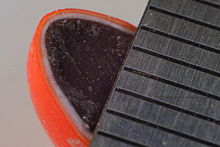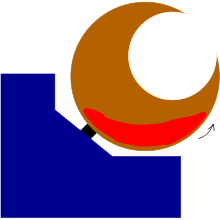- Sugar panning
-
Sugar panning, or simply panning, is a method for adding a candy "shell" to candy or nuts.[1] Popular candies that employ this process in their manufacture include dragées, M&M's, and jelly beans. Jelly beans use soft panning whilst the other two are examples of hard panning. The process was initially invented in 17th century France to make jordan almonds.
Method
Hard and soft panning both are made in a similar fashion, but with different ingredients and at different speeds. A dragée pan is used. This is a circular or oval pan mounted on an angled spinning post. The pan is open to the air to allow ingredients to be added and the syrup to dry. The centers are put in the dragée pan and syrup is added. The pan spins and the syrup is evenly distributed over the centers and dries on as a layer. Soft panned layers can be quite thick and do not well preserve the shape of the center. Hard panned layers take longer to dry and can be typically as thick as 10-14μm.[2]
The choice for centers is wide, but they must be strong enough to not break during the tumbling. Nuts should be dried and sealed, such as with gum arabic and flour, to prevent oils from escaping and discoloring the candy shell. Other centers may be precoated for sealing or to improve the syrup sticking to the center. Chewing gum is difficult to pan without precoating.[3]
Materials
Soft panning uses a syrup which will not crystalize such as glucose. To assist in drying, powdered sugar or caster sugar is added during the tumble.[2]
Originally, sucrose was the sole ingredient used in hard coat panning and is still used in some applications today. However, it has some disadvantages and dextrose has largely replaced it in most hard-panning operations. As an ingredient that represents the greater part of the coating, sugar for some time has been more expensive than dextrose. It also produces a coating that chips more easily and doesn’t color as well. The syrup is sensitive to heat, producing some caramelization, which is better suited to burnt peanuts or similar products. It also will invert if there is too much acid in the coating. Dextrose, on the other hand, suffers fewer of these problems, and coaters, having been fortunate enough to experience the transition from sugar to dextrose, adapted very quickly and were enthusiastic to make the change.[4]
References
- ^ E. B. Jackson (May 1999). Sugar Confectionery Manufacture (2nd ed.). Springer. p. 251. ISBN 9780834212978. http://books.google.com/books?id=GFw8HEqnLvIC&pg=PA251&dq=dragee+panning&lr=&as_brr=0&ei=4MRjSpLPCJDKkATqioCxDg.
- ^ a b Jackson, p. 248
- ^ Jackson, p. 252
- ^ Clark, Warren (2010). "Hard Coat Sugar Panning". The Manufacturing Confectioner (McCutcheon's): 61. http://www.gomc.com/firstpage/201001061.pdf.
Categories:- Confectionery
- Cooking techniques
Wikimedia Foundation. 2010.


